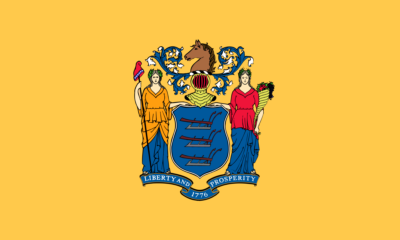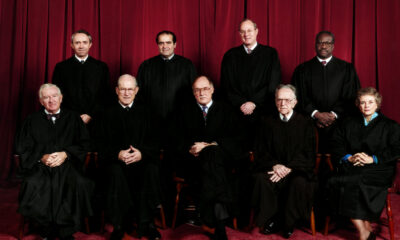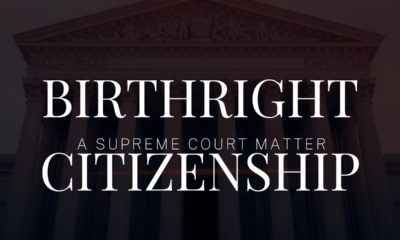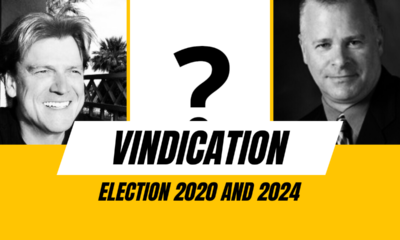Accountability
Supreme Court 2021 – what a term!
The Supreme Court finished its 2021 term, in which it did much to start restoring Constitutional government to the United States.
Yesterday the United States Supreme Court closed out one of the most momentous terms in its history. The Court corrected several profound errors in its past. When the Court did that, it broke its slavish devotion to preserving error for the sake of preserving judicial infallibility. It also helped restore Constitutional government – but also exposed some of the Constitution’s weaknesses.
Supreme Court restores the Constitution
The Supreme Court restored, or helped restore, the Constitution in an important sense. To see why, we must turn to two of its harshest critics from two centuries ago. The first of these was Judge Spencer Roane, then of the Court of Appeals of Virginia (1794-1822). The Supreme Court had just ruled (McCulloch v. Maryland, 1819) that the Second Bank of the United States need pay no taxes to any State bank. In so ruling, Chief Justice John Marshall held that the federal government had an implied power to charter a bank. This power derived from the money-coining power – and the Necessary and Proper Clause (Article I, Section 8, Clause 18). (See here for our discussion of expressed, implied, and inherent powers of government.) By no accident, many Constitutional scholars call this clause the Elastic Clause.
In other words, the Supreme Court read into the Constitution a banking power as an extension of a money-coining power. This outraged Judge Roane. In his view, chartering a bank was neither necessary nor proper to the execution of the money-coining power. Mints coin money; banks borrow and lend money. Furthermore, by denying a State’s power to tax the United States Bank, the Supreme Court revoked a Reserved Power of the States and thus violated the Tenth Amendment!
Judge Roane shared his outrage with Thomas Jefferson, enclosing several op-eds he had published in The Richmond Enquirer. He then asked for Mr. Jefferson’s opinion.
Thomas Jefferson writes back
Jefferson, writing back, fully agreed. First he complimented Judge Roane for espousing “the true principles of the revolution of 1800.” Jefferson regarded his election, and the “flip” of Congress to the Party he and Madison had started, as every bit as revolutionary a change as was the American War for Independence. But that “Revolution” had captured Congress and the Presidency. It had not captured the Supreme Court. And now the Supreme Court, in Jefferson’s view, was betraying his “Revolution.”
[W]e find the judiciary, on every occasion, still driving us to consolidation.
By “consolidation” he meant the reduction of the States to mere districts of the higher-level government, with no sovereignty. But then Jefferson went further. Roane had written, citing Madison in 1800, that:
The judiciary is the last resort in relation to the other departments of the government, but not in relation to the rights of the parties to the compact under which the judiciary is derived.
That compact is the Constitution. But Jefferson saw at once what was wrong. The Supreme Court, being the body of last resort, dictated to Congress and the President what was and wasn’t Constitutional. Nor had Congress used its impeachment power to check this. This led Jefferson to observe that:
the constitution, on this hypothesis, is a mere thing of wax in the hands of the judiciary which they may twist and shape into any form they please.
Proving Jefferson’s point
The further history of the Supreme Court would prove Thomas Jefferson correct in that assessment. Justice Clarence Thomas observed that in his concurrence in Dobbs v. Jackson Women’s Health Organization. He identified a judicial Trojan horse called substantive due process, which had proved just as elastic as the “Elastic Clause.” Thomas blamed this for the decision in Dred Scott v. Sandford, that would start a War Between the States. It also gave us Roe v. Wade (1973).
But that’s not all. Magruder (American Government) has observed, over many editions, that the Supreme Court informally amends the Constitution through its decision making. The history of the Court includes many decisions, some since overruled but many still in force, that infringe Constitutional rights. Dred Scott v. Sandford and Plessy v. Ferguson are the obvious examples, though neither remains in force. The Court corrected the second error, but it took a war to correct the first.
A list of problem precedents
Other decisions that still deserve our attention include:
- US v. Miller (1939), sustaining the National Firearms Act of 1934.
- Everson v. Board of Education of Ewing (1947), forbidding government aid to any religious institution because it was religious. (See here for further discussion of that precedent.)
- McCollum v. Board of Education of School District 71 (1948), the real School Prayer Case.
- Engel v. Vitale (1962), the “School Prayer Case” of legend. The infamous Madalyn Murray O’Hair liked to take credit for that, but she likely didn’t deserve it. The credit – or the blame – goes to James G. Blaine (1875).
- Abingdon School District v. Schempp (1963), another explicit prohibition against Bible reading in class.
- Lemon v. Kurtzman (1971), containing the anti-religious “Test” bearing the name of the petitioner.
- Roe v. Wade (1973).
- Wallace v. Jaffree (1985), forbidding silent prayer time.
- Lee v. Weisman (1992), forbidding baccalaureates or clergy-led prayers during commencement at government schools. (In the USA, a baccalaureate is a religious service for honoring graduates.)
- Santa Fe Independent School District v. Doe (1995), essentially forbidding prayer on school playing fields.
- National Federation of Independent Businesses v. Sebelius (2012), the Obamacare Case.
- Obergefell v. Hodges (2015).
These precedents, more than any others, made hash of the First Amendment (Free Exercise Clause) and Second and Tenth Amendments. They also represent an explicitly atheistic and authoritarian, if not totalitarian, jurisprudence with an obsession with socialism, hedonism, and death.
The Supreme Court comes back part of the way
But in its 2021 Term, the Supreme Court has overruled many of these precedents and put others in direct threat. To be specific:
Roe v. Wade falls to Dobbs v. Jackson Women’s Health Organization. About that case, the country got nearly two months’ warning – though CNAV wouldn’t recommend the method of that warning.
Everson v. Board of Education of Ewing falls to Carson v. Makin.
US v. Miller doesn’t quite fall to New York State Rifle and Pistol Association v. Bruen, but it does come under threat. Federal firearms regulation was not at issue. But State “may-issue” licensing schemes that openly invited arbitrariness and caprice, were.
Lemon v. Kurtzman falls to Kennedy v. Bremerton School District. In CNAV’s view, this decision invites challenges to the McCollum, Engel, Abingdon, Wallace, Lee, and Santa Fe precedents. Had Coach Kennedy really “pushed” it, he could have knocked out Santa Fe as well as Lemon.
In addition to all the above, Clarence Thomas specifically, in his concurrence in Dobbs, invited re-examination of no fewer than three “substantive due process” precedents. Obergefell v. Hodges is one of them. If any precedent will fall from revising out “substantive due process,” it’s that one. (Of the other SDP precedents, Roe has already fallen. The other three precedents will prove much harder to challenge, because they might merely need better reasoning.)
Separation of powers
Besides all that, the Supreme Court threw up a breastwork against further compromise of separation of powers. In West Virginia v. Environmental Protection Agency, the Court held that sweeping economic transformations need real, old-fashioned law. Executive agency regulation won’t serve.
The Court struck another blow, to the bitter chagrin of two of its now-current members. (The third, Stephen G. Breyer, retired yesterday – but the Court’s newest member likely shares his chagrin.) The Supreme Court essentially held in West Virginia that America has not handed itself over to cadres of “experts.” It’s about time – for the history of science and medicine clearly shows that an “expert” remains an “expert” only until someone shows, in ways no one can deny, that this “expert’s” opinion defies common sense. How, then, can any “government by expert” function?
But that’s the hazard of our Constitutional system. Too often the electorate, or a President and Senate, put people into positions of power they can’t or shouldn’t handle. And after that, rarely does anyone make a serious effort to remove them. And when some people do make such efforts, they make them in bad faith. We saw this with Andrew Johnson, and with Donald Trump (twice), and arguably with Richard M. Nixon and Bill Clinton. But to Thomas Jefferson’s point, we have never seen it with a Justice of the Supreme Court. (We have seen it with lower-court judges, most notably Alcee Hastings of the Southern District of Florida.)
The way forward for the Supreme Court – and us
Nevertheless, the Supreme Court went a long way to redeeming itself as an institution in the 2021 Term. In fact the biggest losing precedent is the one no one lists as such, because it isn’t really a case. That precedent is stare decisis, the notion that the Court must let a decision stand, even in error. To observe that without exception is to treat Supreme Court opinions as if they were Papal Bulls and Encyclicals. (Or decrees of the ancient Persian kings; see for instance the Ahasuerus Decrees in the Book of Esther.)
CNAV sees many precedents that deserve to fall, including all the precedents mentioned above, that remain in force and effect. As long as they remain, the country has come back part of the way from being an explicitly atheistic country in which the government may invent a “reason” to deprive people of their right, and the means, of self-defense. Furthermore the weeping and gnashing of teeth we’ve seen from Sotomayor and Kagan JJ, clearly shows the country can backslide.
Be careful whom we appoint – and be ready to stand up for the Constitution
Alexander Hamilton extolled the virtues of an institution, the members of which had lifetime appointments. See The Federalist, essays 78, 79, 80, and 81. The vituperative attitudes of several Members of Congress show that Hamilton likely had something there. But the flip side is that we must be very careful whom we see appointed. That in turn means being careful whom we task with such appointments.
More than that, if court, legislature, or executive tramples on your rights, fight for them. Coach Kennedy did not fight as hard as he might have, so he achieved lesser results. The pro-life movement did fight – patiently at first, then with an all-out push, with the result you know. Gun owners have been fighting for a long time, but some of them need to realize how much harder they can fight. US v. Miller went the way it did because Mr. Miller didn’t fight for his rights. The Supreme Court decided that case by default. Today anyone who declines to challenge an unjust law, executive action, or verdict, loses by default. The same holds for those who will not challenge an erroneous precedent. The problem is that we all lose by such defaults. Coach Kennedy defaulted on some of his rights as surely as Miller did.
This Term shows that the struggle to restore Constitutional government in full is far from futile. Now we must continue the struggle.
Terry A. Hurlbut has been a student of politics, philosophy, and science for more than 35 years. He is a graduate of Yale College and has served as a physician-level laboratory administrator in a 250-bed community hospital. He also is a serious student of the Bible, is conversant in its two primary original languages, and has followed the creation-science movement closely since 1993.
-

 Civilization3 days ago
Civilization3 days agoDC Pipe Bomb Arrest Raises Questions About Christopher’s Wray’s FBI
-

 Civilization4 days ago
Civilization4 days agoThe Legal Logic Behind U.S. Operations Against Narco-Terrorist Networks
-

 Guest Columns5 days ago
Guest Columns5 days agoCongressional Leaders See Far Higher Stock Returns Than Peers
-

 Civilization5 days ago
Civilization5 days agoHow Trump Changed America
-

 Executive4 days ago
Executive4 days agoNewsom’s ‘National Model’ for Homeless Wracked by Fraud
-

 Executive3 days ago
Executive3 days agoWhen You’re in a Hole, Stop Digging
-

 Education2 days ago
Education2 days agoWaste of the Day: Taxpayers Subsidize Football Coach Severance
-

 Civilization2 days ago
Civilization2 days agoPence Calls on Trump To Fire RFK Jr Over Abortion Drug













And I hope our 6 US Supreme Court Justices continue to uphold the US Constitution. And remember, Mr Obama and Mr Biden have no authority to act as President since both the President and Vice-President must both meet the requirements to be serve as President. And the President and Vice-President are being selected as a team Mr Obama and Mrs Harris invalidate the Electoral College votes for their teams.
[…] to their own Constitutions. (Louisiana repealed theirs in 1974.) The Supreme Court itself gave us a slew of unhealthy precedents over the decades. True, the Court has now overruled many of those precedents. But others remain, […]
[…] Supreme Court overturned many of the precedents the atheistic left holds dear, in the 2021 Term. At last one Senator […]
[…] these themes take on even greater importance given relevant Supreme Court rulings in the 2021 Term. In blunt fact, the Supreme Court has reverted to the States many questions that […]
[…] Kennedy and especially Ruth Bader Ginsburg. Their replacements gave us the Dobbs decision. (And the Carson and Kennedy […]
[…] since the Supreme Court closed its remarkable 2021 Term, the enemies of ordered liberty have wailed like banshees. When they contemplate the cases the […]
[…] he’s talking about the remarkable 2021 Term of the Supreme […]
[…] year the Supreme Court put in place many protections that too many want to revoke. These definitely include freedom of speech, free exercise of […]
[…] trends do not look promising. But the 2021 Term of the Supreme Court set many hopeful precedents. They include, of course, Dobbs v. Jackson […]